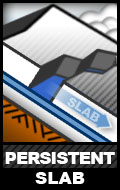Weekend Avalanche Outlook
Expect a beautiful, sunny weekend in the Western Chugach Mountains of Chugach State Park. Despite the wonderful weather that is forecast, snow quality is variable and persistent slab avalanches up to D2.5 in size will be possible for humans to trigger on steep (35*+) terrain above 2500′ on all aspects.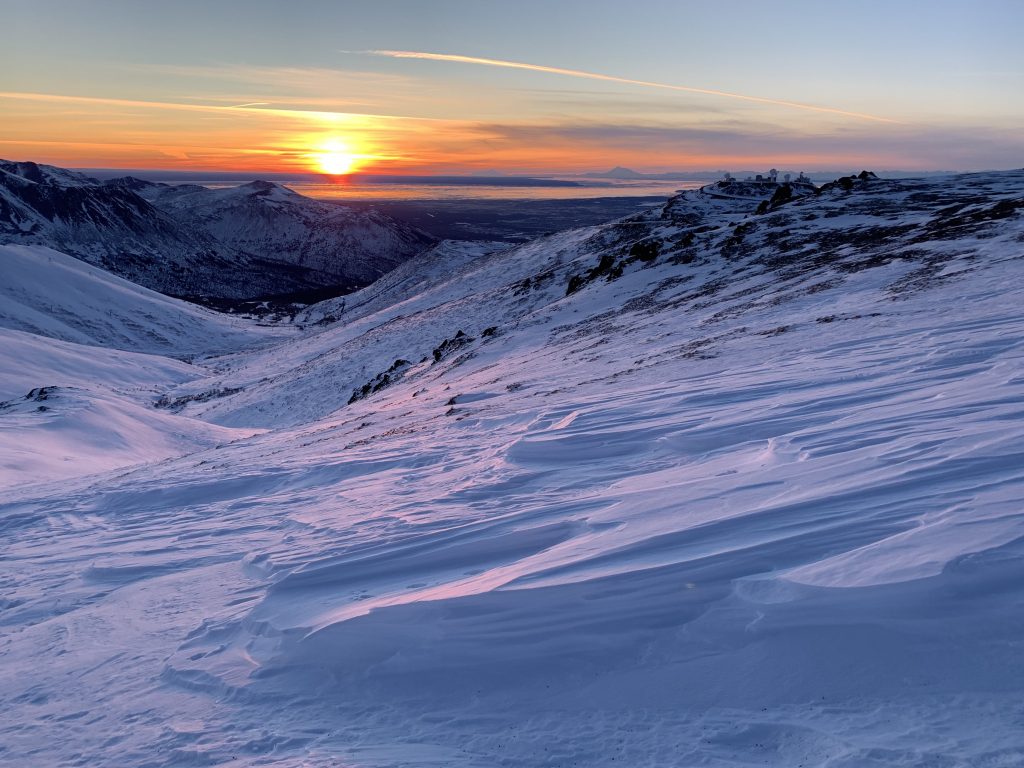 Arctic Valley sunset sastrugi (1/17/19): surface conditions are generally firm with supportable windboard and sastrugi being the most prevalent. Exposed icy crusts, breakable windboard, and isolated pockets of “recycled” (i.e. faceted) powder exist in some areas.
Arctic Valley sunset sastrugi (1/17/19): surface conditions are generally firm with supportable windboard and sastrugi being the most prevalent. Exposed icy crusts, breakable windboard, and isolated pockets of “recycled” (i.e. faceted) powder exist in some areas.
Primary avalanche concern:
The persistent slab problem generally exists in three forms: more recently formed persistent slabs from wind loading earlier this week atop a variety of weak layers and interfaces (exposed crusts, thin faceted layers overlying very firm windboard) resulting from the extended high pressure last week, older persistent slabs that may fail on extensively faceted grains around buried rain and melt-freeze crusts, and the oldest persistent slabs that may fail on depth hoar and basal facets near the ground . Buried surface hoar has not been identified in the Park, and is expected to have been generally dismantled by wind where it may have developed, but cannot be entirely ruled out.
The strength and structure of the snowpack varies throughout the Park, and is generally expected to be weakest and poorest in the northwestern areas (i.e. Arctic Valley north along Knik Arm). Energy has waned due to the relatively uneventful weather the past couple weeks, and absence of any significant stressors. That stated, the snowpack is still expected to be capable of producing small persistent slabs in specific areas and large ones in isolated areas.
These persistent slabs will be difficult to suss out, and will require diligent snowpack assessment with snowpit layer analysis and stability tests like an ECT. They may behave like hard slabs, meaning a human trigger could get into the middle of the slab before it releases from above at a particularly weak spot (i.e. thin area where the “stress bulb” emitted by a human trigger more readily penetrates to the buried weak layer). This means escape could be especially difficult.
It will be very important to be mindful of the runout zone of any slope you’re on, and avoid terrain traps that could greatly exacerbate the consequences of even a small slide. Besides terrain traps that channel debris making for potentially deeper burial, it will be important to be mindful of exposure especially as “slide-for-life” hardpacked conditions exist in many areas.
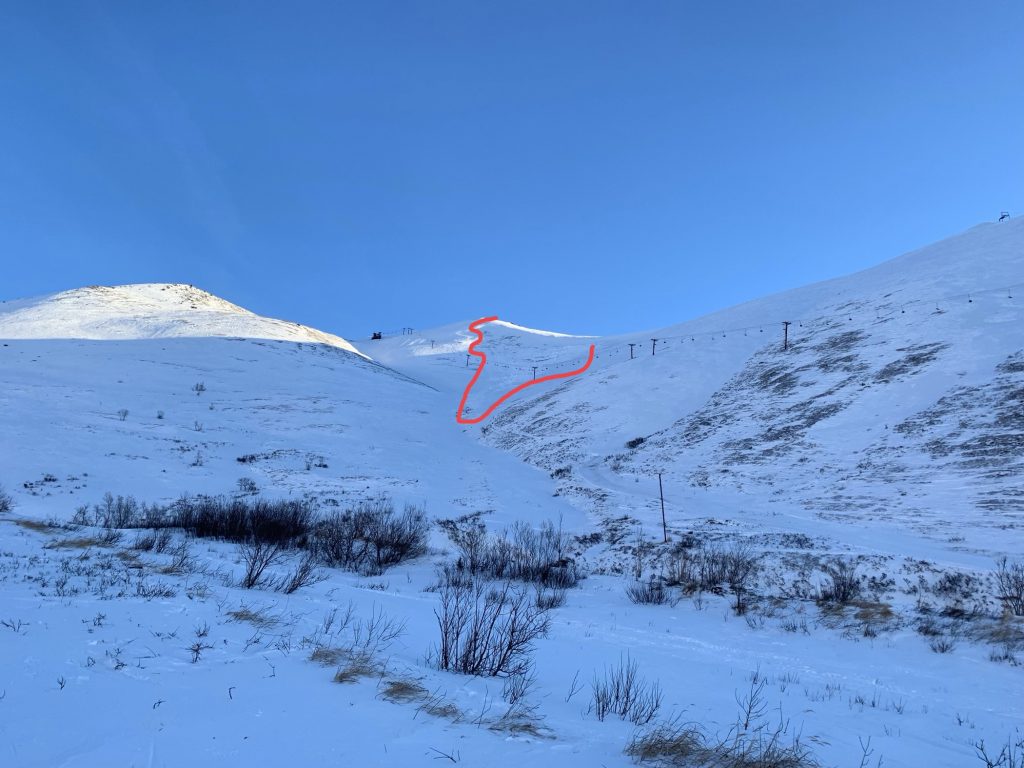
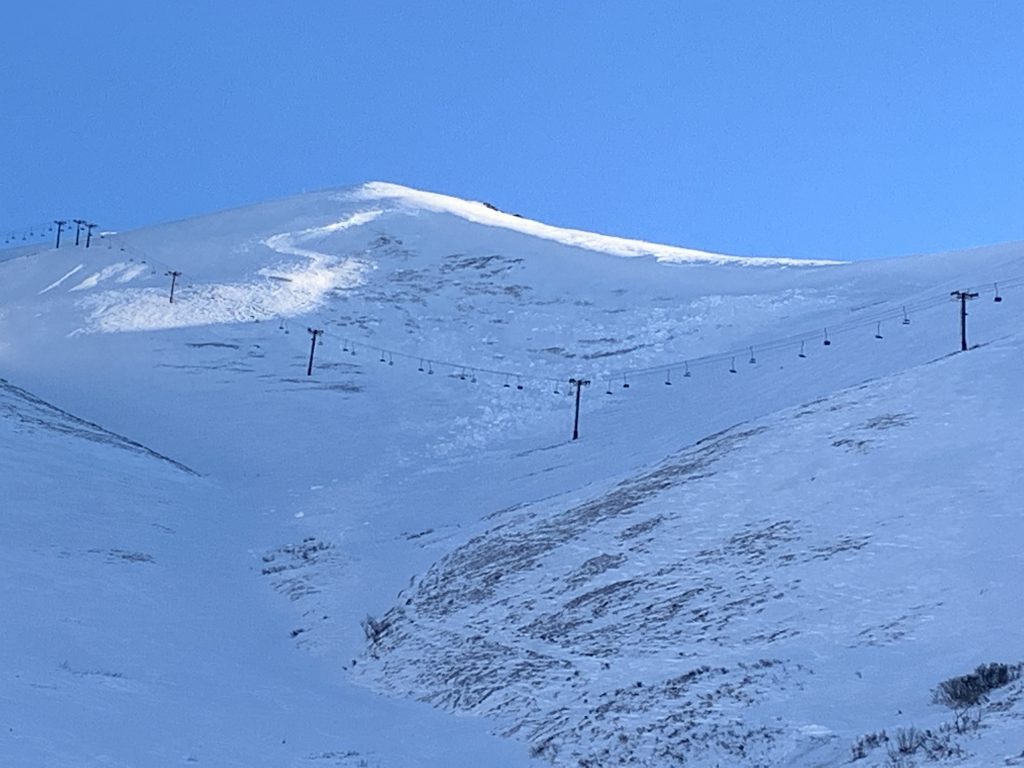 This old persistent slab (suspected to have been naturally triggered by the New Year’s wind event) in-bounds at Arctic Valley Ski Area is the largest one observed in this area since forecasting for Chugach State Park began in December 2012. It is evidence of how nasty the snowpack is in some areas: significant basal facet and depth hoar development near the ground, and extensive faceting around buried melt-freeze and rain crusts.
This old persistent slab (suspected to have been naturally triggered by the New Year’s wind event) in-bounds at Arctic Valley Ski Area is the largest one observed in this area since forecasting for Chugach State Park began in December 2012. It is evidence of how nasty the snowpack is in some areas: significant basal facet and depth hoar development near the ground, and extensive faceting around buried melt-freeze and rain crusts.
Secondary concern:
Cornices are relatively large at this point in the season, especially compared to what we’ve experienced the past couple years. A cornice fall itself is dangerous, but could also trigger a large persistent slab avalanche as it “bombs” the slope it falls onto. Give cornices a wide berth, and don’t approach the edge of a snow covered ridge unless you’re sure it’s not corniced. Cornices can break off much further back than expected (even beyond where they’re overhung), especially given their generally very dense and firm current state.
General notes and recommendations:
It will be a lovely weekend to get out and enjoy your local public lands, the beautiful views they provide, and to get some outdoor exercise (which greatly enhances personal wellbeing). It’s important, for health, to get outdoors even in the winter. However, winter backcountry travel brings a unique set of hazards. In addition to the cold, one has to contend with snow and avalanches. Many popular areas and trails in Chugach State Park, where people recreate without avalanche danger in the summer (non-snowy) months, cross and/or are exposed to potentially dangerous avalanche terrain and paths.
Yesterday at Arctic Valley, three hikers were observed on the steepest part of a heavily wind loaded slope directly above a terrain trap. They were traveling on this route (presumably) because the snow was supportable and they didn’t enjoy postholing in the unsupportable, windward, and thinner snow that avoided the terrain trap and was not really in avalanche terrain (i.e. snow covered areas 30*+ in steepness or exposed to the runout of terrain 30*+ in steepness). As one of the three was kicking hard into this slope for traction, and subjecting the slope to stress that could potentially trigger an avalanche, I yelled over to see if she was wearing an avalanche beacon and to see if she knew she was in avalanche terrain directly above a terrain trap. She responded that she was not and did not. I told her the area she and her partners were in was especially dangerous and that they should move back over to the lower angle terrain with exposed rocks and tundra even though the hiking was annoying due to the postholing, because it was much safer in terms of avalanche danger.
This situation is more proof and evidence that Chugach State Park needs an avalanche information program beyond just public observations submitted to the Chugach National Forest Avalanche Information Center (CNFAIC) whose staff is unfamiliar with the State Park, has little experience with its terrain and snowpack, and does not edit or contextualize the information they receive.
It is also more proof and evidence that the greater Anchorage area outdoor community needs more avalanche education directed at hikers, mountain runners, fat-bikers, XC skiers, etc. that don’t intentionally seek out avalanche terrain for recreational purposes but only inadvertently travel through and around it.
For several seasons the Anchorage Avalanche Center provided advisories like this one, but has been limited in its ability to due so in more recent seasons due to constraints resulting primarily from the CNFAIC dominating local fundraising and working against (rather than with) the Anchorage Avalanche Center in terms of providing info for Chugach State Park’s winter backcountry recreationists.
We hope that those involved with the CNFAIC will put egos and personalities aside, and work with us at the Anchorage Avalanche Center via an eye-level relationship based on mutual respect and appreciation to bolster avalanche information and education efforts for Chugach State Park. Last season, the Anchorage Avalanche Center reached out to both the CNFAIC and Alaska Avalanche School (AAS) with this letter in hopes of coming together to provide something better for our outdoor community. However, the letter was blatantly ignored and disregarded by both the CNFAIC and AAS.
It’s up to our local community to demand change, in regard to the current dysfunction of Alaska’s professional avalanche community. All of us involved with the Anchorage Avalanche Center project desperately want this change, and are more than willing to work with all interested parties in building and developing the Chugach State Park avalanche information and education program. However, this will not happen until some individuals come down from their ivory towers and positions of “authority.”
As the Anchorage Avalanche Center project has demonstrated, it would only cost $20,000/season to provide an organized avalanche information and education program for Chugach State Park that includes a weekly advisory, twice weekly observations, and varied educational offerings throughout the season.
If you recreate in the mountains during the snow season please make sure you have at least a basic level of avalanche awareness that enables you to identify and avoid potentially dangerous avalanche terrain and paths, practice “safe travel protocols for avalanche terrain,” and effectively use avalanche rescue equipment (beacon, shovel, probe).
When you head out for your adventure, leave a “trip plan” with a friend or family member staying in town so they could respond in the event of an accident.
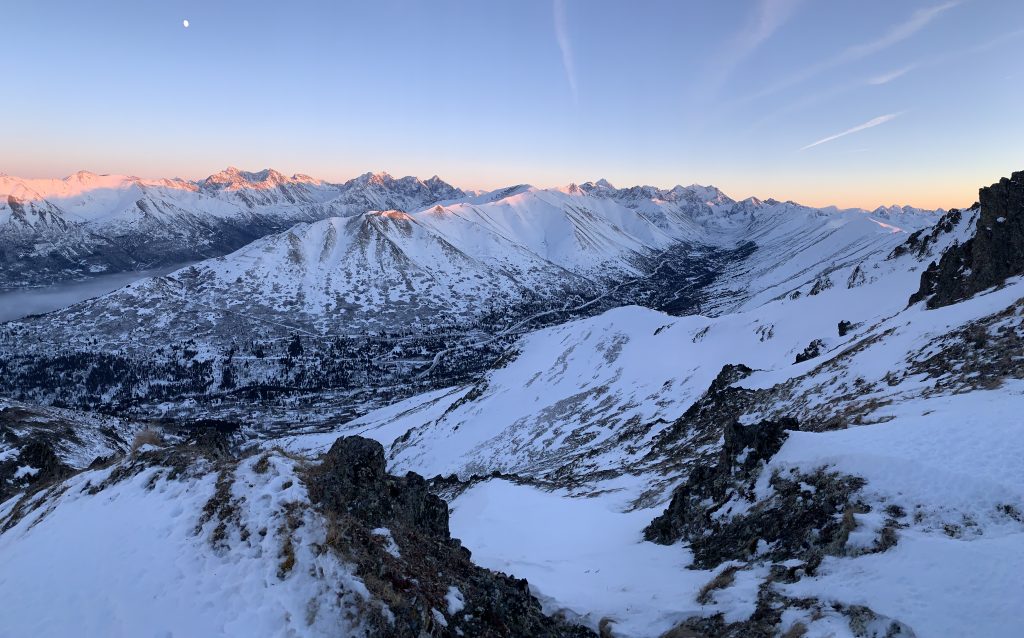 The North and South Fork Eagle River valleys from Mt. Gordon Lyon at sunset 1/17/19
The North and South Fork Eagle River valleys from Mt. Gordon Lyon at sunset 1/17/19 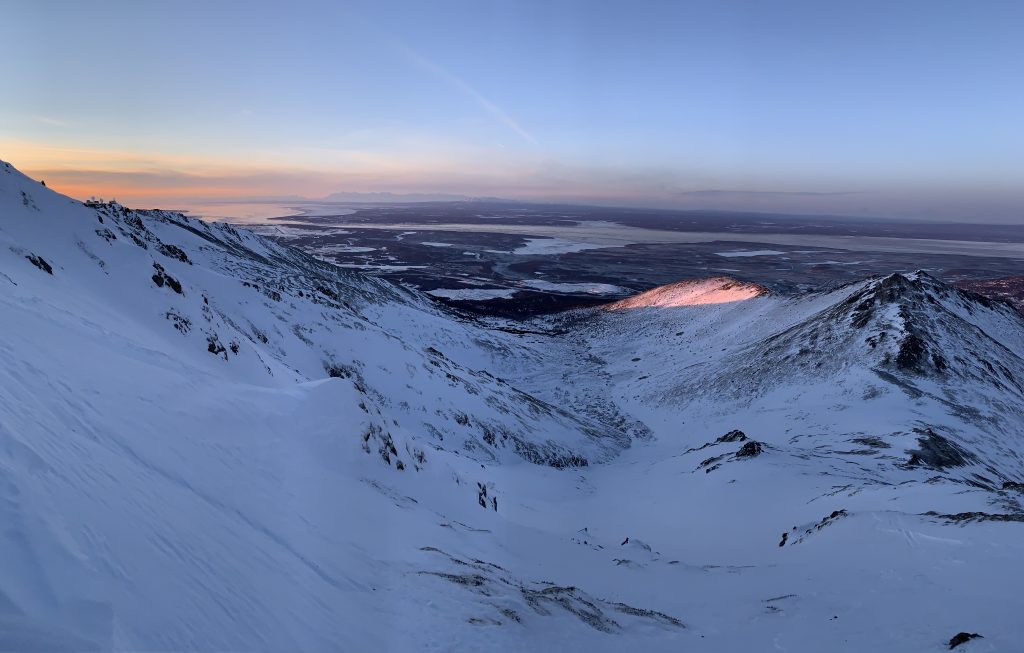 Southern Knik Arm & northern Cook Inlet from Mt. Gordon Lyon at sunset 1/17/19
Southern Knik Arm & northern Cook Inlet from Mt. Gordon Lyon at sunset 1/17/19
*Click the hyperlinks and icons throughout this page for further learning*


